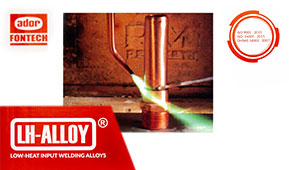Table of Contents
- Non-fusion Welding – Advantages & Disadvantages
- Four Requirements of Brazing Process
- Clean Metal
- Filler Rod
- Heat Source
- Flux
- Advantages of Flux-coated Brazing Rods
- Importance of controlling heat brazing & Key benefits with Flux-coated Brazing rods
- Brazing Process
- Flux coated brazing rods & their uses
Brazing is a part of non-fusion welding process where only the filler rod is melted. Brazing Rods are available as bare rods as well as flux coated brazing rods. Flux Coated Brazing Rods can be used for brazing & braze welding application.
Non-fusion Welding – Advantages & Disadvantages
- Advantages
- Lower temperature
- Easy assembly
- Weld dissimilar metals
- Allows disassembly/realignment
- Join metals of different thicknesses
- Joint different types of metal
- Disadvantages
- Lower tensile strength
- Not efficient method for thick metal
- Not efficient method for large parts
Four Requirements of Brazing Process
- Clean metal
- Appropriate filler rod
- Correct flux or Flux coated Brazing Rods
- Heat
Clean Metal:
- The brazing process bonds metal through a property called adhesion.- Where adhesion can be defined as the molecular attraction which is exerted between bodies when they come into contact.
- Such bonding between molecules requires the surfaces to be clean, not polished.
Filler Rod
- Brazing:
- Brazing rods are available as bare rods or flux-coated brazing rods
Heat Source:
- The heat must be sufficient (in BTUs) to raise the base metal temperature above the melting point of the filler rod to solder or braze the joint.
- Several heat sources can be used.
- Oxy acetylene
- Air acetylene
- Air propane (LPG)
- Oxy propane
- Electric soldering iron
- Electric soldering gun
Flux:
- Flux must be used with brazing processes.
- Three purposes of flux.
- Chemically clean the metal
- Shield weld from oxidation and atmospheric contamination
- Promote wetting
- Choice of flux depends on both the metal and the filler material.
- Flux comes in three forms.
-
- Paste
- Powder
- Liquid
Advantages of Flux-coated Brazing Rods.
- No external flux required
- Addition of alloying elements
- Better Bonding with uniform Flux
- Better Properties as bonding achieved
- Simpler process for welder
Importance of controlling heat brazing & Key benefits with Flux-coated Brazing rods
- Metals are excellent conductors of heat
- Heat applied to a joint is conducted away from the joint.
- The heat required by the process depends on the amount of metal that needs to be heated.
- Excessive heat causes the flux coating to burn
- It can contaminate the joint.
- Joint may need to be cleaned again
- When we use flux-coated brazing rods, we can manage the application of heat to make it even ensuring controlled wetting and high-quality brazing properties.
Brazing Process:
The brazing process uses a metal alloy that melts above 450oC, but less than the melting point of the base metal. The brazing process is aided by capillary action through which the filler metal gets drawn into the joint or stays in the joint. The capillary effect determines the ability of a liquid to wet a given material. This process is made possible by a very small gap between metal surfaces, clean surfaces, and flux.
Flux coated brazing rods & their uses.
Flux coated brazing rods are used for their capillary action and their ability to offer a higher build-up. Flux-coated silver brazing rods are used in close fit joints with capillary action.
Also, Cu based bronze and brass alloys are used to join thicker sections without capillary action. Flux coated brazing rods with tungsten carbides are used for hardfacing applications in industries. This process is called braze welding; In this process, the Brazing happens above 750⁰C but below the melting temperature of the base metal.
Unique advantages of flux coated brazing rods is that they can be used equally well in applications requiring capillary action and in applications that need higher build up or hardfacing through braze welding.
ADFL is first among the few companies in India that manufacture Flux Coated Brazing Alloys. This product range of Ador Fontech underlies our concept of Life Enhancement of Industrial components to the complete satisfaction of customers.
Reclaim. Do not Replace.


